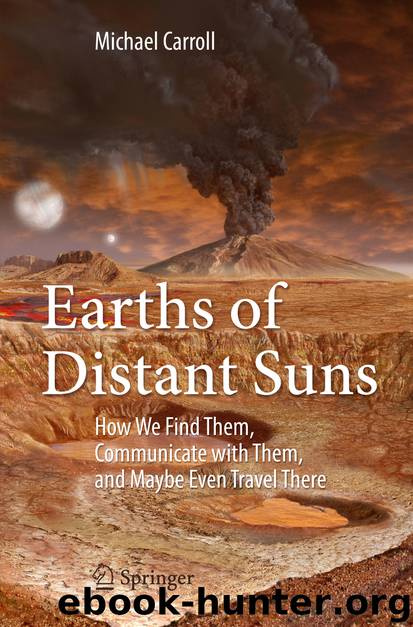Earths of Distant Suns by Michael Carroll

Author:Michael Carroll
Language: eng
Format: epub
Publisher: Springer International Publishing, Cham
Enceladus: Europa on Steroids
Europa made waves in the astrobiology community, but scientists would soon see something even more remarkable—a smaller moon with far more extensive activity. Enceladus is a remarkable world. A tangle of twisted ridges abut cracked plains nearly devoid of craters. These plains appear to have been resurfaced in the geologically recent past. Other regions are heavily cratered. All surfaces of Enceladus are among the brightest terrain in the Solar System, intimating that the entire moon is dusted with fresh material.
A scant 504 km across, Enceladus would barely span the country of France. Because of its diminutive size, Enceladus’ geologically young surface mystified researchers. Neighboring Saturnian moons were cold, dead places, despite the fact that many were larger.
Circling close in to Saturn, Enceladus races around the golden giant once each 32.9 h. The orbit of Enceladus is out of round, comparable to that of Io, so some researchers assumed that tidal forces might be strong enough to trigger some kind of internal activity. Other geologists suggested that its interior might be heated by a wobbling motion of the satellite caused by the tug of nearby moons.
The small ice ball has a big tale to tell. Enceladus floats within a gossamer donut of fog surrounding Saturn. Saturn’s faint E ring actually envelopes the orbits of several of Saturn’s moons, well beyond the main rings that made Saturn famous. Scientists knew for some time that a mysterious source was continually replenishing the fog. Observers also discovered that the ring was dominated by very small ice particles. Such tiny flakes should only last for decades to centuries; something had to be recharging the faint torus. Some researchers suspected that the ring's fine particles were somehow related to Enceladus itself. They were right, but no one suspected how extraordinary the relationship was.
In 2004, the Cassini spacecraft settled into orbit around the ringed giant. Immediately, the robot felt the effects of the E-ring: the environs of Saturn are inundated with floating atoms of O2. A trio of flybys from February to July of 2005 finally confirmed the presence of cryovolcanic (super-chilled) activity. The imaging science team first spotted curtains of fine mist against the dark sky. Magnetometer readings confirmed the discovery, detecting ions streaming from the moon's rarified atmosphere. Temperatures in the plumes measured as high as –136 °F (some 200° higher than the surrounding environment). This temperature is consistent with a mix of water and ammonia. Cassini’s Ion and Neutral Mass Spectrometer detected ammonia in the plumes.
Flight engineers modified Cassini’s orbit to pass within 168 km of the surface. Team members wanted detailed data on the magnetic fields and a shot at more detailed geyser images, but they got more than they bargained for. Cassini sailed directly through an extended plume of material. The spacecraft detected 90 % water vapor, with traces of carbon dioxide, methane , acetylene, propane, and possibly carbon monoxide, molecular nitrogen, and soupçons of quite intricate carbon-rich molecules. In addition to all that chemical excitement, the ice particles in the plumes contain sodium chloride (ordinary table salt) and other salts.
Download
This site does not store any files on its server. We only index and link to content provided by other sites. Please contact the content providers to delete copyright contents if any and email us, we'll remove relevant links or contents immediately.
| Aeronautics & Astronautics | Astronomy |
| Astrophysics & Space Science | Comets, Meteors & Asteroids |
| Cosmology | Mars |
| Solar System | Star-Gazing |
| Telescopes | UFOs |
Turbulence by E. J. Noyes(7110)
Tools of Titans by Timothy Ferriss(7024)
Astrophysics for People in a Hurry by Neil DeGrasse Tyson(4657)
Room 212 by Kate Stewart(4155)
Pale Blue Dot by Carl Sagan(4060)
The David Icke Guide to the Global Conspiracy (and how to end it) by David Icke(3935)
Secrets of Antigravity Propulsion: Tesla, UFOs, and Classified Aerospace Technology by Ph.D. Paul A. Laviolette(3717)
A Journey Through Divination and Astronomy by Publishing Pottermore(3366)
Apollo 8 by Jeffrey Kluger(3225)
Losing the Nobel Prize by Brian Keating(3200)
Goodbye Paradise(3023)
COSMOS by Carl Sagan(2984)
How to Read Water: Clues and Patterns from Puddles to the Sea (Natural Navigation) by Tristan Gooley(2912)
Brief Answers to the Big Questions by Stephen Hawking(2905)
The Five People You Meet in Heaven by Mitch Albom(2878)
The Order of Time by Carlo Rovelli(2777)
How to Read Nature by Tristan Gooley(2693)
A Brief History of Time by Stephen Hawking(2505)
Aliens by Jim Al-Khalili(2413)
